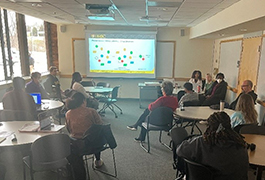Passing the Chapter Officer Baton

In any relay race, the most nerve-racking moment is the handoff of the baton from one runner to the next. All eyes are on the two runners in the exchange zone, and everyone is hanging on to the hope of a smooth pass. Even though runners are trained for their leg of the race, in that moment, where timing is everything, the only thing that matters is precision and connection.
In a lot of ways, transferring chapter duties to new officers is similar. A chapter can go an entire year without significant hiccups and succeed in many areas. The chapter can grow in numbers. Students can excel at outreach and community building. A record number of people can attend a chapter-sponsored event. But when the officers and leaders behind those events graduate, all the knowledge and progress could be lost because time was not taken to share that knowledge.
When the baton isn’t passed to a new cohort of leaders, meeting attendance drops, opportunities are missed, and momentum is slowed.
This slump can be avoided with careful planning. Elite runners don’t just run toward a teammate and wildly toss the baton hoping that it will be caught. There’s a rhythm, a meter, and a plan. Likewise, successful chapters set up a rhythm and a plan to transfer duties to incoming officers to keep the chapter on track.
Share the knowledge
Faculty advisors are invaluable resources for a chapter, but ultimately it is a student chapter. Student officers need to be responsible for the organization’s collective wisdom. That’s why many chapters create a library of chapter documents: charter, bylaws, officer duties, event time lines, templates for letters and flyers, and so on.
At Tennessee Tech University, each executive committee member has a binder for their role, and it is passed from officer to officer, says Amanda J. Carroll, the faculty advisor.
“In the binder for each position, there is a time line and a list of activities related to that position, for reference,” Carroll explains. “Each binder also contains a general time line for events that are done every year. The binders also contain contact information for people in community groups we work with,” Carroll says, adding that “each executive committee member adds information to their binder throughout the year, so the information grows from year to year.”
The binders help to transition new executive committee members into their roles, “since it provides expectations for what needs to be done and when deadlines are,” she says.
Documents can also be maintained and shared digitally. At Saint Joseph’s University, the executive board is implementing a collection of best practices using an online platform. “We are in the process of creating specific and detailed bylaws that we will be able to hand down from year to year. We also have created a shared Google Drive that we will be able to pass down to future years,” says former student Elise Brutschea, one of the chapter’s co-presidents.
If this seems overwhelming, your chapter can start by making sure that chapter bylaws are detailed and up-to-date. Then, create a master chapter calendar so that annual events don’t sneak up on new leaders. Next year’s officers will be able to look at the calendar and note things like when to begin preparing for National Chemistry Week. You should also write down things as you do them, like whom you contacted for guest lectures, so that next year’s officers will know whom to contact.

Looking ahead
How you fill leadership roles is equally important for smooth chapter transitions. The student chapter at West Virginia State University relies on having active elections to keep the whole chapter involved and invested in the future. A single set of elections is held in the fall; all chapter members are welcome to run, but running for office takes planning.
“For a student to run for an officer position, they need to present their ideas for what they wish to accomplish in their role and how they intend to go about this,” explains former student Edgar Lopez-Torres According to Torres, requiring would-be officers to develop and communicate their plans engages all of the chapter members. When officers are elected with goals and plans in mind, the chapter can help the officers achieve these goals, he says.
At Tennessee Tech, members who want to hold an officer position must be nominated by another chapter member, and then they present their vision for the role. “Each nominated person gives a short speech about why they want a certain position, and then we vote on that position,” Carroll explains. A nomination process also spurs current officers and other members to encourage and mentor potential leaders.
The Tennessee Tech chapter has an eight-member executive committee with four elected officers: president, vice president, secretary, and treasurer. The chapter also has four appointed committee chairs: green chemistry, fundraising, social, and education outreach.
“People wishing to obtain the chair positions submit an application we provide, with why they’re interested in the position, what they think they can bring to the position in terms of skills and ideas, and their anticipated class schedule for the upcoming year,” says Carroll. “The outgoing and incoming officers get together to select the chairs for the next year. We do this since the outgoing officers know what is needed to be successful in a position and the incoming officers will be working with them the next year.”
Moving to the application process has “provided better opportunities for people to obtain positions they are best suited for,” Carroll explains. “And it helped first- and second-year students have more success in getting involved in leadership roles, since they may not be as well-known as juniors and seniors.”
Engaging new students
Successful chapters always attribute at least part of their success to having active and engaged first- and second-year students, not just an excellent governing board of juniors and seniors.
At Saint Joseph’s University, the traditional executive board of four juniors and seniors wasn’t working. “Our involvement was very small when our board was structured this way,” Brutschea says. “We decided to restructure the board to encourage more involvement in the club from first-year students through senior students.”
The chapter doubled the size of the board. Now there are two co-presidents, a treasurer, and a secretary. These positions are elected in the spring. The chapter added a scholarship chair, a science outreach chair, a fundraising chair, and an external relations chair. Students are elected to these roles in the fall, and any chapter member is eligible.
“Electing some members of our executive board the year before allows our chapter to prepare over the summer and start [chapter] activities as soon as the school year starts,” Brutschea says. “We have seen that having a more diverse board, in terms of major and class year, helps encourage involvement. It also helps with continuity from year to year; having created these new positions, we hope the younger students who were elected to the chair positions will move up to the president roles.”
The student chapter at West Virginia State University has only four executive officers, but the chapter has built succession into the election process. The role of vice president is usually filled by someone who is not graduating, explains Lopez-Torres, who served as his chapter’s director of fundraising for scholarships. The vice president is encouraged to serve as president the following year.
Some chapters will go a step further and have a period of overlap between incoming and outgoing officers. This allows the previous officers a chance to mentor the new officers and help them adjust to their new roles.
Last thoughts
None of these tips guarantees strong chapter transitions year after year, and not every approach will work for every chapter. But the best practices of successful chapters are worth considering to maintain momentum: create a reference library of foundational documents to follow, build a pathway of involvement for all chapter members, and invest in your election process so that leadership roles go to members with a vision for the chapter.





